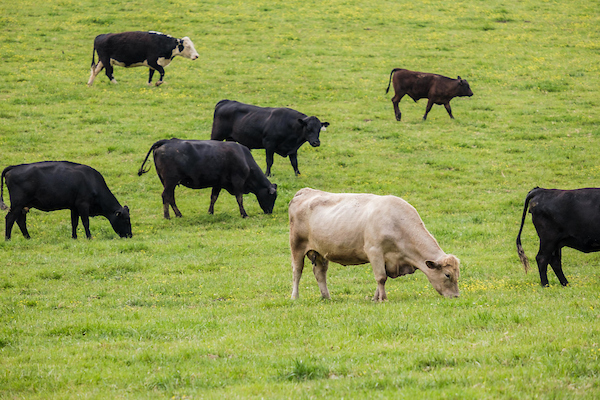The Rise and Improvement of Tall Fescue
The Rise and Improvement of Tall Fescue
Published on June 16, 2025

As forage research was well underway in Princeton, UK agronomist E.N. Fergus stumbled into forage history on the other side of the state in 1931 when he was asked to judge a sorghum syrup show. Invited to also visit the Suiter Farm in Menifee County during this trip, Fergus observed “an excellent stand of grass on a steep hillside.”
According to Garry Lacefield1, former UKREC Extension forage specialist, this was the most crucial farm visit in the history of Kentucky agriculture. Fergus identified the grass as a tall fescue and returned with a few pounds of seed for testing.
UKREC was instrumental in sharing this discovery. It was first seeded in research trials at Princeton in 1932, tested for many years (see the note about the Arvin family's involvement at the end), and then released by Fergus in 1943 as “Kentucky 31.” By the 1950s, Kentucky 31 tall fescue had become the most widely grown cool-season grass due to its adaptability and strong performance under pasture conditions.
“It fit into Kentucky,” said Lacefield, who worked at UKREC for his 41-year career, from 1974 to 2015. “It was tough. It would grow anywhere. It started to grow early and would grow late in the season. Farmers really liked it because it was such a good grass, and they could all grow it.”
Unfortunately, it also had its disadvantages. Farmers and researchers observed problems in cattle that grazed in Kentucky 31 pastures, including reduced weight gain, heat stress and hoof problems. This condition, eventually called fescue toxicosis, is caused by a fungus within the plant’s cells, or endophyte. It can also affect sheep and cattle.
Once the endophyte was identified, a collaborative effort at UKREC in the 1970s between Lacefield, Extension agronomist and soils specialist Monroe Rasnake, and Extension animal scientist Roy Burris produced effective strategies to help cattle producers reduce their livestock's exposure. The practices they developed for managing endophyte-infected pastures are still recommended today.
UK researchers also looked to remove the endophyte from the plant entirely. By 1982, they developed an endophyte-free variety called Johnstone (named after forage specialist W.C. Johnstone). Without the endophyte, however, the resulting fescue lost much of the hardiness that had made it a popular pasture forage. With fescue toxicosis still taking a heavy financial toll on Kentucky's beef industry, Lacefield knew they needed a variety with an endophyte that would bolster the plant's resilience without being problematic for livestock—a nearly impossible pipe dream.
A laboratory in New Zealand eventually discovered a novel endophyte, marketed as Max Q, in 1997, and new fescue varieties were developed. UK plant breeder Tim Phillips developed a Kentucky-born, endophyte-free tall fescue using the Max Q endophyte in the early 2000s and tested it for 12 years. Lacefield Max Q II®, marketed by Pennington Seed Company, was released by the University of Kentucky in 2018. Phillips named the variety for Lacefield upon his retirement to honor his numerous contributions to the forage industry and the college.
By Susan Baniak and Jennifer Elwell, University of Kentucky Marketing and Agricultural Communications
1 TALL FESCUE IN KENTUCKY: THE FIRST 80 YEARS Garry D. Lacefield Extension Forage Specialist University of Kentucky. 2011.
2 Submitted by David Arvin of Hopkinsville:
My father and his brothers were the first growers of Kentucky 31 Fescue in Christian County. I have heard about E. N. Fergus discovering the grass on the Suiter farm in Menifee County and how he was impressed with the green hillside where it grew. I was told he stripped a small quantity of the seed by hand and brought it back to the UK lab for growing and observation.
A few years later, when the grass was ready to be released, W. C. Johnstone asked Christian County Extension Agent W. D. Talbert if he knew any farmers willing to plant the grass and grow it for seed. Mr. Talbert immediately thought of the Arvin brothers, who had shown an interest in growing any new crops that would let them make some money. I am told the first year's crop was a near failure, but Mr. Johnstone urged them not to give up. The second year was a very good crop, and for the next 15 years or so, fescue seed was an important cash crop on the Arvin farms. As a boy, I remember riding the combine, tying the sacks of seed, and dumping them on the ground. Also, as a much younger boy, I remember Mr. Johnstone coming to the farm for a visit. In later years, I became acquainted with W. C. Johnstone's son, United States District Judge Ed Johnstone, who swore me into the federal bar. To my surprise, Judge Johnstone knew of his father's relationship with my family, and he always mentioned it when I appeared before him.
Having the opportunity to grow the grass and sell fescue seed proved to be an enormous blessing for my family. It paved the way for all five children of a poor, uneducated farmer to go to college and get degrees. Two of these children, Paul and Tim Arvin, remained on the farm and expanded it from a modest 300-acre operation to its present-day size of more than 3,000 acres.
